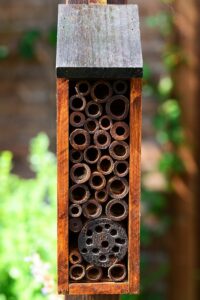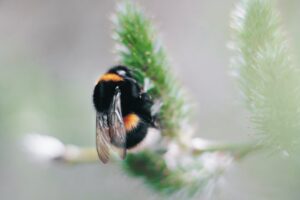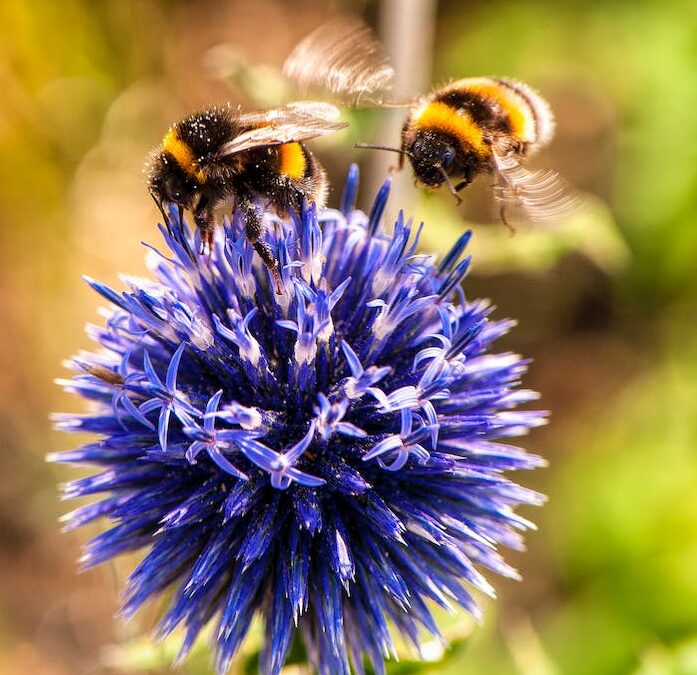In my last post I went on at length about European honeybees and their importance in agriculture and pollination. I hold to that stance but ever since that story posted I’ve been barraged with messages, scathing criticisms, even a few death threats. They all had the same thing to say,
“Adam, what are you doing giving all the credit to the honeybees? There are so many native bees out there putting in the work, grinding it out, pollinating a broad range of plants. Get your priorities straight you hack!”
or something to that effect.
I’m here to tell you that you have been heard! I formally apologize for my omission and want to make amends. A supplement to take the sting…out of my mistake. That means…YES! Another clickbaity internet countdown list!
-
Carpenter Bee
Kicking it off, the carpenter bee flies under the radar because of its resemblance to the bumblebee. The similarities end at looks though because they are quite different. Carpenter bees are solitary and can pose a threat to your home’s structural timbers. They make their home by drilling an almost perfectly circular hole, ½ in wide, strait into the wood. They use this hole for shelter as well as to lay their brood. Although the hole of one bee may not compromise the wood too much, the same hole may be used by many generations, getting enlarged each time, leading to significant damage. They are important pollinators despite the fact that they engage in nectar robbing. A practice where the bee can get to the nectar of deeper flowers by cutting a hole in the base of the flower from the outside and drinking the nectar without entering the flower, denying it of the pollen it needs to procreate.
-
Wool Carding Bee
Wool carder bees are unique in that while most bees are covered in hair, they are instead a shiny black with regular yellow spots running down its sides. It is also unique in the males aggressive mating behavior. The female needs to collect wooly fibers from certain plants to make their nests. The larger males (which is also uncommon) know this and will post up on a single plant and wait for the females to arrive, guarding it from other male carder bees and will even start bumping into humans that enter its territory, because that’s its move. The male carder bee lacks a stinger so is more of a tackler grappler type. It does have two spikes on the end of its abdomen which it uses to crush and bludgeon its opponent. It will then mate with any female that comes to collect from the plant although the female will try to avoid them. 1/10, do not recommend. Want to more information about this strange little bee? Check out this article from USDA!
-
Metallic Sweat Bee
With their genus being Agapostemon, which translates to “stamen loving”, it’s no surprise that these little bees (9-11mm), go to show that big time pollinators can come in small packages. Sweat bees come from the family Halictidae, which is represented by around 400 species in North America north of the Mexico border. Agapostemon are typically a metallic green or blue with the males of some species having black stripes on their abdomen. They make their homes in tiny burrows in the ground where they shelter and lay their young. They get their name from their tendency to get in people’s faces, attracted by the moisture and salt content of human sweat.

-
Blue Orchard Mason Bee
When we get calls about these little ladies, its usually because people think that they are the previously mentioned carpenter bees. This is because they are all about preparing their nest for their brood, and to lay their brood they need a tunnel. They will often use a piece of bamboo. A hollow reed or twig or stem of a plant is also a good fit. Our customers get worried when they use the exit holes of wood boring beetles that have emerged from the timbers of their porch or deck. It’s easy to imagine that the little bee that’s in and out of the hole is the one that caused the damage in the first place. However, it’s really just packing in material for its offspring.
It starts by creating a ball of pollen and nectar that it collects from nearby flowers and then lays a single egg on that ball. Once that’s done the bee then collects mud and creates a wall in front of it sealing it off in the tunnel to keep it safe. This is how it gets its mason moniker. It will then repeat the process. Pollen, egg, mud, pollen, egg, mud, creating cell after cell until the tunnel is full. The eggs will hatch and feast on the pollen that their mother has left throughout the summer whereupon they will pupate and overwinter, finally emerging in the spring as adults.
The good news for homeowners is you can just give them time in the spring to emerge and then fill the holes with wood filler and paint or put a sealant on the wood. They should leave it alone after that and the bees get to do their thing without harm. Why would you want to harm them? They are amazingly efficient pollinators! It takes a lot of pollen to feed those babies. That’s a lot of flowers to visit and a lot of pollination getting done. The only reason they aren’t the primary pollinators are that they only have about 15 offspring a year, whereas the honeybee will lay 500 eggs a day!

-
Bumble Bee
The bumble bee is the darling of the native bee enthusiast world. I get it, they’re fluffy and loveable. True to their name they fly around in a clumsy meandering way, bumping into flowers and just generally bumbling around. It’s easy to give them a personality. In my head they’re very Winnie the Pooh like. They even have that myth about them where a scientist studied them and determined that according to the laws of physics, they shouldn’t be able to fly, but nobody told the bumblebee, so it flies around blissfully ignorant of its un-aerodynamic nature. Mind over matter.
Bumblebee queens emerge in the spring, sometimes as early as January, and start on their quest to find a suitable location to start up their nest. This is typically in the ground, usually in an abandoned rodent or bird nest. I’ve seen them nest between bales of hay, wall voids, and even in birdhouses. In a season the queen will lay 50-600 worker bees. The future queens and fertile males are produced late in the season. They will mate and then the future queens will find a place to overwinter, emerging in the spring to start the cycle again.
Although they are a social bee and feed on flowers nectar, they also produce honey although not in the quantities that their honeybee cousins do. They also make wax, but instead of the super organized honeycomb, the bumble nest is a bunch of ovular containers that they use to contain their food and young. For me its reminiscent of the scene in Aliens where Ripley finds the room full of the Xenomorph eggs? They’re full of those face hugger guys that parasitize humans then BOOM out it comes! Sorry, I digress, I’ll have to cover parasitic insects though. Anyway, they kinda look like those eggs.
Here’s the bad news, Bumbles are on the decline. There are many contributing factors to this problem. The mechanization of agriculture has taken away habitat. It’s decreased the use of draft animals to care for crops which reduced the need for feed crops like alfalfa and meadowland for animals to graze, leading to less wildflowers. It also led to the increased use of engineered fertilizers and pesticides.
There are certain species that are disappearing from our area or are going extinct entirely. There are certain groups like the Pacific Northwest Bumblebee Atlas that are, with a small army of volunteers, serving as a rallying point. Doing mass surveys of the area, counting bees, and IDing them. Trying to get an idea of where we stand so we can decide on how to move forward. (They can always use some help so click that link and volunteer.)
In the meantime, it’s up to us to mitigate any further damage to our native pollinator populations by acting responsibly. Landscaping with plants that will attract and sustain populations and using pesticides with the utmost care is important for pest control operators and homeowners alike. If you find a nest, don’t spray out of fear of being stung. There’s always another option and we need them more than they need us.
Live and let live,
Adam Hiddleson



